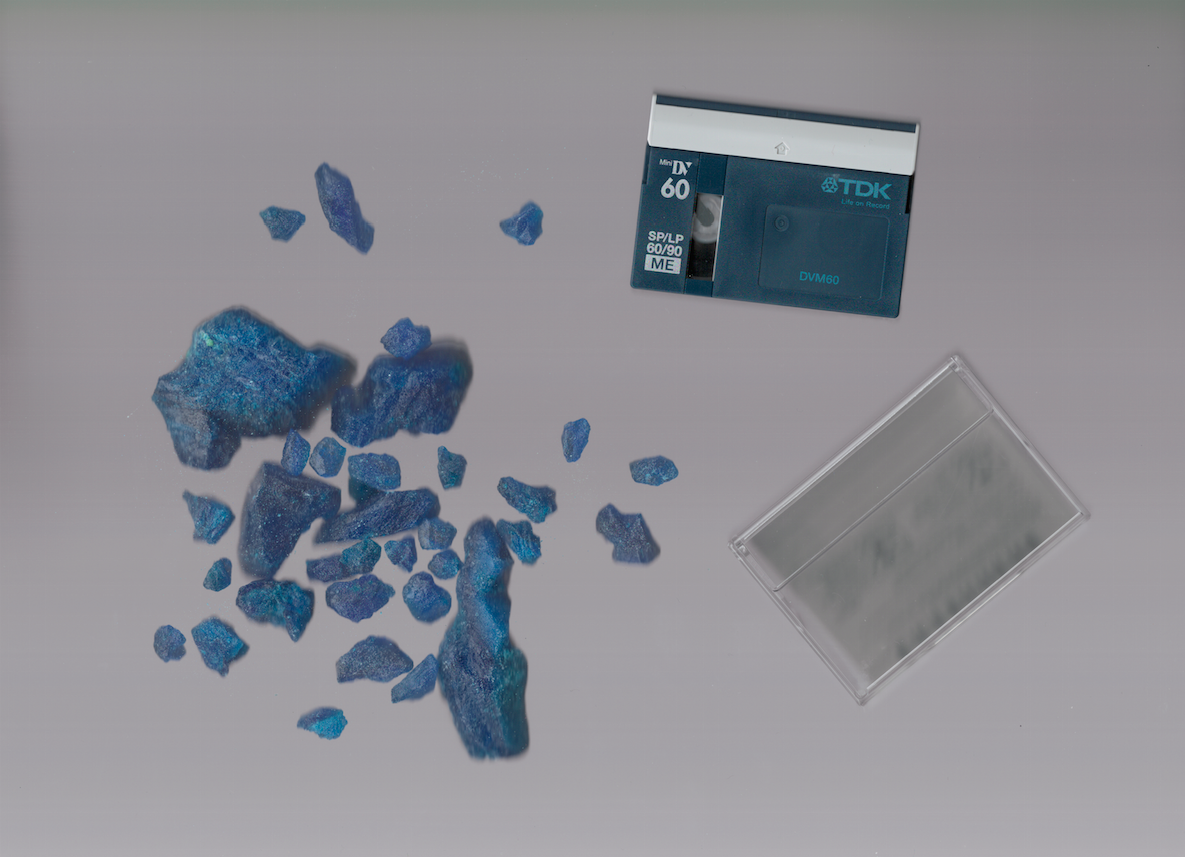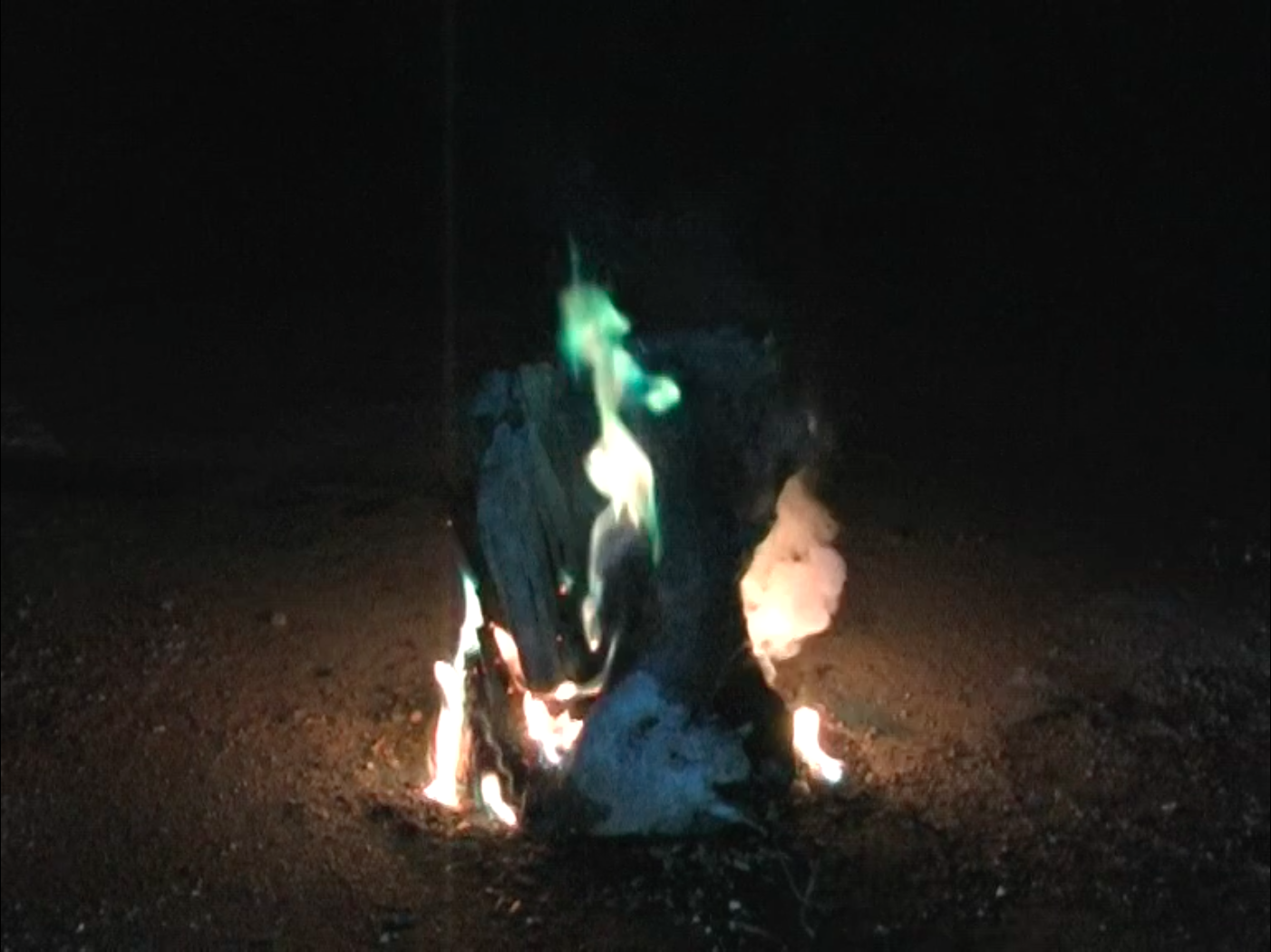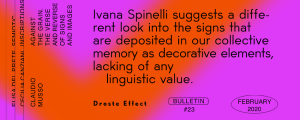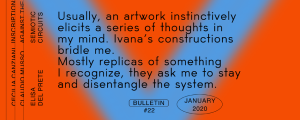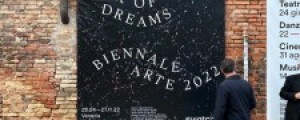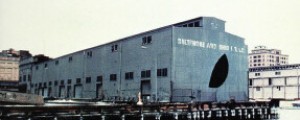Life is messy and moving all the time: A collective writing experiment at Ramdom
Life is messy and moving all the time
by Claudio Zecchi, Simona di Meo, Roberto Memoli, Nuvola Ravela and Jacopo Rinaldi
This text is a collective writing experiment on several levels – visual, video, sound – made during the week of workshop that I curated at Lastation (Gagliano del Capo, Italy) for the project Sino alla fine del mare. A residency and investigation project focused on the Extreme Lands, organized by the association Ramdom and curated by Paolo Mele.
Simona di Meo, Roberto Memoli, Nuvola Ravela and Jacopo Rinaldi were the four artists selected to participate.
The four projects are an exercise in small reasoning; they constitute four clues, investigating different aspects of the extreme landscape of the so-called Capo di Leuca. They aim at reactivating the complexity of boundaries (both geographical and anthropological), history, memory, and tradition, but also the urgency of the present in a state of continuous exchange with the local community.
The text that follows, written by me with the four artists, has everything and at the same time nothing to do with their final work.
The entire publication at the following link: https://sinoallafinedelmare.tumblr.com/

Sino alla fine del mare, Ramdom/Lastation, Gagliano del Capo (LE)
Simona Di Meo, Jacopo Rinaldi, Roberto Memoli, Nuvola Ravera, Alberto Gemmi
in the workshop session curated by Claudio Zecchi
___
The last of the things chronologically done – assigning a title to this text – is the first to come into sight in order of appearance. The extreme synthesis of a fragmented path that has tried to generate wider perspectives around the specific work of the four artists – Simona di Meo, Roberto Memoli, Nuvola Ravela, Jacopo Rinaldi – selected for Ramdom’s residency program Sino alla fine del mare.
The title comes from a statement released by British artist Martin Creed to a journalist during the opening of his solo at Hauser & Wirth in Bruton, Somerset. Creed says: «I was trying not to plan this show too much. [...] Life is messy and moving all the time [1].»

Sino alla fine del mare, Ramdom/Lastation, Gagliano del Capo (LE)
Simona Di Meo, Jacopo Rinaldi, Roberto Memoli, Nuvola Ravera, Alberto Gemmi
in the workshop session curated by Claudio Zecchi
In a completely unintentional way, the title, and perhaps more generally Creed’s approach to work, has somehow inspired the whole process, and in particular this text, that we could define as an attempt at collective writing. An experiment that not only tends to seek and identify the limits of a horizontal and open practice, but possibly even to undermine it.
A tool capable of creating in some way the prerequisites of a multi-voiced dialogue, in which everyone takes part in the common challenge of building a different singularity within a path that does not deny the presence of a vertical scheme – in this case, the traditional way of thinking and writing a publication – but rather, and paradoxically, recognizes it in the first place.
Isabell Lorey claims that democratic practices «have to be negotiated with others in a concrete situation of confrontation and newly invented again and again. The point is not to take over power, but rather to continually open up a presentist space for the unpredictable, anarchic invention of the future, the re-organization of the commonality – a process that is no way linear. To further design and organize this, new forms of verticality are needed which build a non-representationist practice of horizontality and do not halt the process of a constituent power [2].»
Horizontality, therefore, is not and was not the aim of this path (if not in part) but a tool of self-determination aimed at identifying (if possible) a new way of self-organizing.

Sino alla fine del mare, Ramdom/Lastation, Gagliano del Capo (LE)
Photo taken during the exercise Caderno de Campo as part of the workshop session curated by Claudio Zecchi
Caderno de Campo is an exercise by Helena Cavalheiro (Architect / Researcher, University of São Paulo)
When, in 2015, Creed was invited to give a talk/lecture at the Vera List Center for Art and Politics at the New School in New York, he started by recognizing the limits or perimeter of that format – the talk/lecture, precisely – and then began to subtly question them through a performative attitude that manipulated those same limits to impose new ones [3].
In the same way, writing a publication that has little to do with a publication in a classical sense, is a way, or rather a strategy, to renegotiate its borders by recognizing in the first instance and, in an almost ontological dimension, that same format – the publication precisely – by its own name.
This means generating a dynamic capable of fostering a performative aptitude, aimed at renegotiating the same language in a trajectory that aspires to think a different and new imagery, narrated rather than functional, in discontinuity with the previous one already assigned.
More than with the content, or the contents of the individual paths that are also widely present in this publication – see the photos, the videos and the sounds – without ever being explicitly declared, the title has to do with a precise methodological choice aimed at renegotiating the language, at rethinking the formats, at using devices as a place of discussion and, ultimately, at building a kind of ideal stage capable of arranging the conditions of the verification of the impossibility. The impossibility of being together, the inability to really listen, the inability to communicate [4], and to create those necessary fractures that make it possible to build a different way of narrating.

Sino alla fine del mare, Ramdom/Lastation, Gagliano del Capo (LE)
Simona Di Meo, Jacopo Rinaldi, Roberto Memoli, Nuvola Ravera, Alberto Gemmi
in the workshop session curated by Claudio Zecchi
Doing this implies a loss of power and control within that dimension that German artist Hito Steyerl would define with the word “groundlessness” or, to say it in Bifo’s words, a condition of immanence.
In the first case, this becomes an experience in which the traditional ways of seeing and perceiving are shattered, and the lack of «stable ground on which to base metaphysical claims or foundational political myths» pushes us to be (at best) «faced with temporary, contingent, and partial attempts at grounding [5].» A loss of power and control whose apparent weakness can be flipped into a potential meaning of strength.
In the second case, however, it could be interpreted as a kind of immanent quality: a condition of presence in the process, «the intrinsically or inherence of something to something.» Something that contains the future within the present as a wide range of possibilities, where choices, however, are never prescribed or predetermined [6].
In the end, as Lacan also claimed, «the object is always insufficient, it always represents the void. The object has failed because it is never reached [7].»
The case we faced can be thus described as a fragmented path in which different disciplines or practices such as politics, activism, territory, community, architecture, urbanism, philosophy, psychology, etc., in the words of Simon Sheikh, «sometimes connect, sometime close-off and that are in conflictual and contradictory relation to each other [8]» – a place where certainties are finally elaborated in terms of exceptions, exclusions, inconsistencies, and contradictions.
Jacopo Rinaldi, Intervallo
Intervallo is a moving work. The installation consists in the replacement of a train window shades with printed curtains reproducing still shots from a 1935 newsreel. The sequence is a one-second footage divided into the number of the train windows.

Jacopo Rinaldi, Intervallo, Installation on a railcar FSE Ad 41, 34 digital print on cotton Panama Flo, 70cm x 115 cm each, 2017
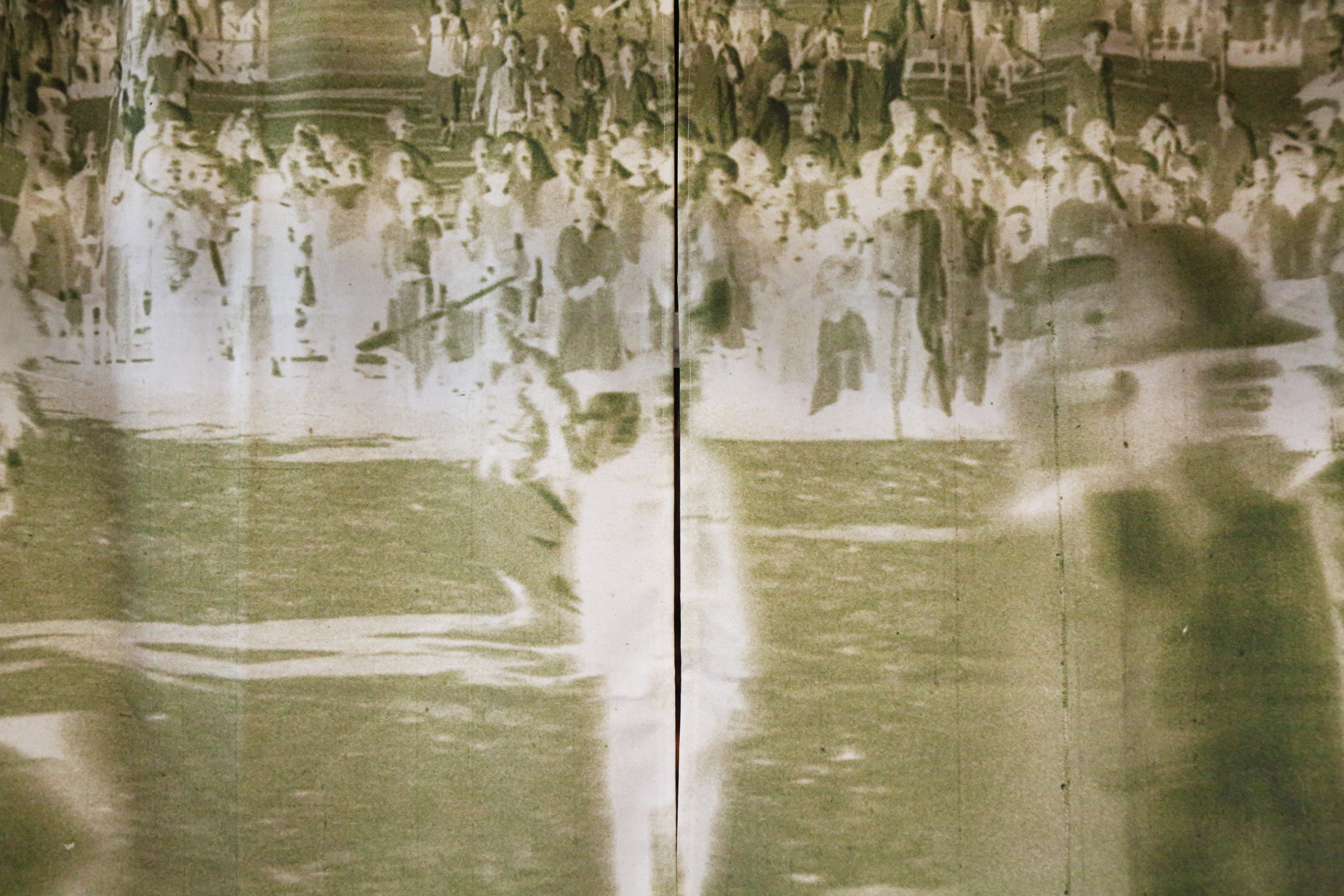
Jacopo Rinaldi, Intervallo, Installation on a railcar FSE Ad 41, 34 digital print on cotton Panama Flo, 70cm x 115 cm each, 2017
Nuvola Ravera, Le storie dell’azzurro – pratiche sulla soglia per malattie immaginarie
Nonlinear narrative of the patient-landscape through 4 acts of micro-transformation of the context.
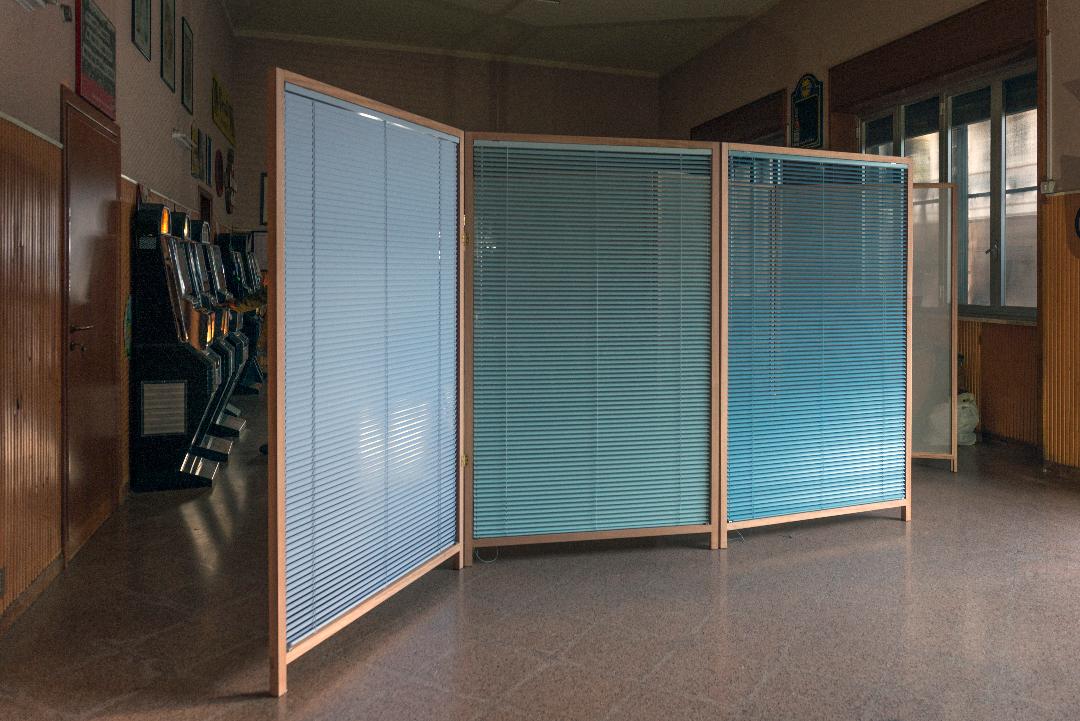
Nuvola Ravera, Act 1. Mal di madre, performance, 2 screens 3 x 2 m approx., wood, lycra and venetian blinds, 2017
Eight o’clock in the evening. At Bar 2000 in Gagliano del Capo, four women behind two screens pass each other a megaphone. They talk about the territory and its illness.

Nuvola Ravera, Act 2. Occhio non vede, bocca non parla, performance on the walled door, concio di tufo, 2017
A wall of bunches was drilled by a worker in order to allow the reopening of the vision or to give the word to a building located on Monteduro Street at Gagliano del Capo. A child looks across the hole to find out what is hidden inside.
Roberto Memoli, Verderame
Verderame, a synthesis of the drastic change in the landscape of Southern Apulia (the Italian region where this Ramdom residency takes place), tells about a moment of transition through a sound installation and a silent video.
Simona Di Meo, Is crossing borders an intimate act?
Is crossing borders an intimate act? presents the first step of a research project that investigates the relationship between the communities that reside on the Italian, Greek and Albanian borders, with the aim of narrating a new story from an intimate, domestic and informal point of view.

Simona Di Meo, Is crossing borders an intimate act?, Installation view, Typographic matrix of narrative posters, aluminium slab, 87×90 cm, 2017

Simona Di Meo, Is crossing borders an intimate act?, Postcards, Excerpts from interviews by inhabitants of Gagliano del Capo, typographic printing blue-Silver, 18x13cm, 2017.
[1] “I was trying not to plan this show too much,” he explains as he begins to walk us through the show. “Life is messy and moving all the time.” (Artsy.net) The translation is completely free. It has to be read as a key to interpret a path whose way has been made backward tracing, where only at its end a hypothetical encounter between all the practices on stage is possible. This publication is, therefore, an attempt to create a dialogue between works held together by a methodology or a spirit.
[2] I. Lorey, «On democracy and occupation. Horizontality and the need of new form of verticality,» in Institutional Attitudes, Instituting Art in a Flat World, P. Gielen (ed.), p. 86.
[3] Watch https://www.youtube.com/watch?v=6a85XMBkT2M.
[4] «[…] The theater needs a field of possibilities and a field that apparently can be an over the field and instead is just the field. That is the site of the verification of the impossibility here, is the place where the impossibility must be tested. That is to say that we must always find the impossibility of being together, the inability to really listen, the impossibility of a real communication. If one can recreate this impossibility in the theatre, it may be, that this impossibility can also be transferred to the public. Because there is the problem of the execution, of the possible execution and the possible execution must be calculated, but the possible execution is as much possible, as much calculated, to allow then the impossibility, the unexpected. The theatre is the place of the unexpected. The unexpected of emotion must be educated through the listening between humanity. In This case, we are two different (actors/writers) persons who always speak in the same body and this huge distance has a possible meeting point. The meeting can take place. The impossibility and the distance must start from listening among us» (Mimmo Borrelli in Faccia Gialla). Faccia Gialla narrates, from far away, the genesis of the extraordinary play Sanghenapule, a work on the blood of Naples and Saint Gennaro, written by Roberto Saviano and Mimmo Borrelli. A film concerning the possible-impossible encounter between Roberto Saviano, the voice of Naples, narrating the earthly and celestial life of the Patron of Naples, and Mimmo Borrelli, who suddenly “appears” and becomes his body. Faccia Gialla is a film by Paolo Boriani. (Rai.it)
[5] H. Steyerl, «Free Fall: A Thought Experiment on Vertical Perspective, in The Wretched of the Screen,» e-flux journal #24, April 2011. (e-flux)
[6] «[…] The future is inscribed in the present as a tendency that we can imagine: a sort of premonition, a vibrational movement of particles that are taken in an uncertain process of continuous recombination.» F. Bifo, Berardi, The Age of Impotence and the Horizon of Possibility, Introduction, Verso, London-New York, 2017, p. 13.
[7] T. Macrì, Fallimento – La disfunzione riscattata, Postmedia, 2017, p. 15.
[8] S. Sheikh, In the Place of the Public Sphere? Or, the world in Fragments, in republicart, June 2004. (republicart)
by Claudio Zecchi
in Focus on Europe
Feb 9, 2018




